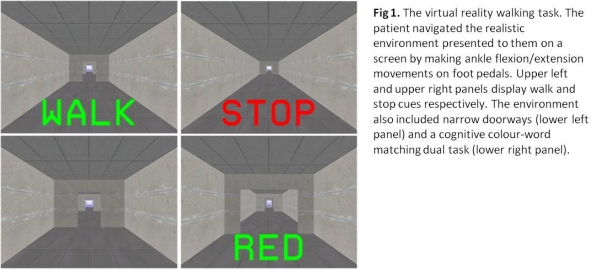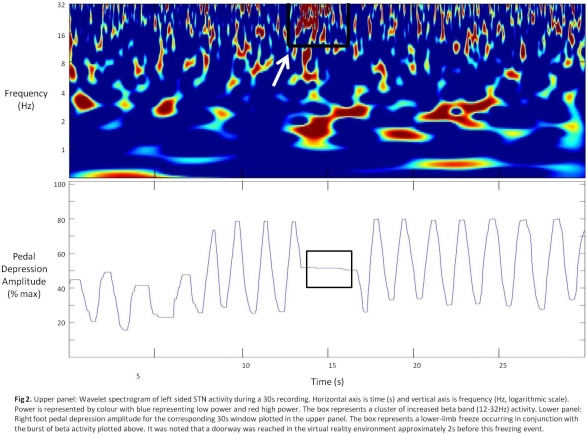Session Information
Date: Tuesday, June 21, 2016
Session Title: Pathophysiology
Session Time: 12:30pm-2:00pm
Objective: Record subthalamic nucleus activity in a Parkinson’s disease patient with gait freezing while they perform a virtual reality walking task during DBS surgery.
Background: Freezing of gait (FOG) is a common disabling symptom of PD but knowledge of its pathophysiology remains incomplete. Building on work using virtual reality (VR) to study FOG with fMRI [1] we examined patterns of STN neuronal firing during successful walking in VR and VR-provoked lower limb freezing.
Methods: Intraoperative DBS microelectrode (0.5-2MΩ) recordings were taken from the STN of a 58yo male with PD and FOG simultaneously performing a VR walking task requiring ankle flexion/extension movements on footpedals to navigate a realistic environment presented on a screen (fig1). Recordings were filtered and down sampled (500Hz) before continuous Morlet wavelet transformation. The signal was synchronized with VR events, footpedal depression amplitude and lower limb EMG. Neuronal firing patterns were examined by plotting power of frequency oscillations (0-32Hz) on a wavelet spectrogram within sliding windows corresponding to the events of interest: 1) VR walking 2) doorway encounter 3) dual task 4) VR freezing (>2x the patient’s modal VR step time). 
Results: STN neuronal firing pattern changes were identified with lower limb freezing elicited by the VR task. We observed increased STN activity in the beta frequency band (12-32Hz) with breakdown in footpedal amplitude and rhythm associated with a VR freeze. This occurred commonly in conjunction with a doorway or cognitive dual task in the VR environment (fig2). Clusters of beta band power increases were not observed as prominently during periods of successful VR walking. 
Conclusions: Our findings suggest that use of a VR walking task to elicit lower limb freezing in combination with intraoperative STN recordings is a viable way to study FOG in PD. Beta oscillations in the STN have been shown to occur more prominently in patients with PD and FOG than those without FOG, albeit in the resting state [2]. The VR approach herein described enables investigation of neuronal firing profiles during the temporal evolution of behavioural freezing episodes. This will improve understanding of the pathophysiology of FOG in PD, potentially leading to the development of therapies including a closed loop DBS system, improving quality of life for many patients.
| 1. | Shine, J.M., et al., Exploring the cortical and subcortical functional magnetic resonance imaging changes associated with freezing in Parkinson’s disease. Brain, 2013. 136(Pt 4): p. 1204-15. |
| 2. | Toledo, J.B., et al., High beta activity in the subthalamic nucleus and freezing of gait in Parkinson’s disease. Neurobiol Dis, 2014. 64: p. 60-5. |
To cite this abstract in AMA style:
M.J. Georgiades, M. Gilat, J.M. Shine, J. McMaster, N. Mahant, S.J.G. Lewis. Subthalamic nucleus activity during virtual reality provoked lower limb freezing in a patient with Parkinson’s disease and freezing of gait [abstract]. Mov Disord. 2016; 31 (suppl 2). https://www.mdsabstracts.org/abstract/subthalamic-nucleus-activity-during-virtual-reality-provoked-lower-limb-freezing-in-a-patient-with-parkinsons-disease-and-freezing-of-gait/. Accessed December 14, 2025.« Back to 2016 International Congress
MDS Abstracts - https://www.mdsabstracts.org/abstract/subthalamic-nucleus-activity-during-virtual-reality-provoked-lower-limb-freezing-in-a-patient-with-parkinsons-disease-and-freezing-of-gait/
